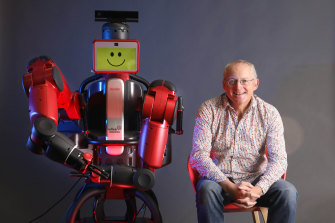In 2020, a team of MIT researchers used an AI algorithm to search a pool of 100 million molecules for new antibiotics.
The AI struck gold. It identified a molecule that can kill a range of bacteria, including the increasingly drug-resistant bug that causes tuberculosis. The scientists named the molecule halicin, referencing the scheming supercomputer HAL from 2001: A Space Odyssey in tribute to the molecule’s AI identifier.
“I’m sorry, Dave, I’m afraid I can’t do that.” In the 1968 sci-fi classic 2001: A Space Odyssey, a computer called HAL (Heuristically programmed ALgorithmic) takes over a spaceship.Credit:Fair Use
But the origin of AI-developed technology is also its shackle. Only humans can be listed as inventors on patent applications, meaning life-saving discoveries made by AI can’t be patented and progressed into products.
“We’re in this sort of legal black hole, where you can’t file a patent because there isn’t a human inventor,” said UNSW AI expert Professor Toby Walsh.
“That’s going to perhaps discourage invention, discourage companies investing in making new drugs, if they can’t protect things that are found with the help of, or even exclusively by, AI.”
Australia became the first place in the world to decide that an AI system could be listed as an “inventor” on a patent last year, before the Federal Court overturned the decision in May.
Professor Stephen Thaler, a US-based AI pioneer, brought the case because he wanted to patent two products “invented” by an AI system he created known as DABUS (a Device for the Autonomous Bootstrapping of Unified Sentience).

AI expert Professor Toby Walsh has called for international patent law reform to allow the recognition of non-human inventors.Credit:UNSW
One of the products developed by DABUS is a beacon Thaler dubbed a “neural flame”. It’s a device that maximises the chance of attracting attention in an emergency by flashing in a sequence based on human brain activity. The other invention is a drink container made of a “fractal” material ideal for being handled by prosthetic or robotic hands.
Stay connected with us on social media platform for instant update click here to join our Twitter, & Facebook
We are now on Telegram. Click here to join our channel (@TechiUpdate) and stay updated with the latest Technology headlines.
For all the latest Business News Click Here
For the latest news and updates, follow us on Google News.
